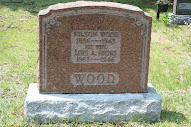It was a bright, warm, sunny Spring Day on May 27th
and I packed up a little cooler of snacks and drinks and hit the road! I headed to Arden to visit the Arden United
Church Cemetery, the public library, and then onward to Northbrook to the
cemetery there.
According to Find-a-Grave, a website used by many to locate
the graves of ancestors, Mary Woodcock and William Wood are assumed to be
buried in the Arden cemetery. My plan
was to walk the cemetery in search of a headstone or marker for Mary Wood
(Woodcock) or William Wood. The cemetery
is on both sides of the Arden Rd. in a somewhat remote area surrounded by
trees. I snapped a shot of the sign and
the first thing I noticed was that it was established in 1880. My theory is that Mary died prior to the 1851
census so I was pretty sure I wouldn’t find her here.
However, I had made the trip and I took the chance to walk
it and photograph other Wood headstones in case I linked any of them in the
future to the tree. I did take a few
pictures but have yet to connect them to the tree. Unfortunately, as I suspected because of the
date on the sign, no Mary or William.
From the cemetery I travelled to the library. It is a small one room library next to the Kennebec
Community Hall (Arden Community Centre).
The library had a few books, and I took the time to go through each one.
First on the list was a transcription of the graves at the
Arden United Cemetery of Kennebec Township.
This was done for the Ontario Genealogical Society (OGS) in 1986. Which confirmed that neither William nor Mary
was buried there.
The next was Gaylord, Bordenwood, Henderson United, Elmtree,
& Parks Farm Cemeteries also transcribed for the OGS. These were cemeteries close enough to be
considered but there were no Wood names.
I researched several other area related books to see if any
names within the tree could be found.
Broadening the search to anyone within the family can often lead to
other records that can lead to that specific person you are looking for. Another purpose in taking the time to read
these published books is that they list the sources of information. These might be sources I can look up to see
if there are additional records I can find.
The books I researched while there included:
- 150 Years 150 Women 150 Stories
- 1861 Census of Bedford, Kennebec, Olden, Oso Townships of
Frontenac County.
- Forty Years of Kennebec Township, Frontenac County, Ontario,
1861-1901 Vol. 1
- Forty Years of Kennebec Township, Frontenac County, Ontario,
1861-1901 Vol. 2
I did find some of my ancestors in the books and created a
list of other sources to look at. So, my
trip to Arden was not a waste of time.
If nothing else, it eliminated the a few possible burial spots for
William and Mary.
Since then, I have reached out to the Minister at the Arden
United Church and asked about historical records. She has informed me that the United Church of
Canada was not established until 1925 and she is not sure where one can find
records prior to that time. Which I
suppose does make one wonder about the cemetery being dated 1880.
On the United Church of Canada website, it confirms that the
church as inaugurated on June 10, 1925, and is a union of the Methodist Church,
the Congregational Union of Canada, and 70% of the Presbyterian Church of
Canada. My Wood ancestors were
Methodist. But where to find the
Methodist records before 1925? That is
the question.
My trip to Northbrook was to revisit the Northbrook
Cemetery. I had been there in 2012 with
my mother after a family reunion in Flinton. At the time, I didn’t know a great
deal about my mom’s side of the family.
I wanted revisit the headstones now that I know more about them and the
extended branches.
Another reason for visiting the cemetery is that I was
contacted by a DNA match through Ancestry.
We discovered that we are fourth cousins through brothers George Wood
(my 2x great-grandfather) and William Wilson (her 2x great-grandfather). We are both researching the Wood line and
helping each other where we can. I took
some time to see her tree and wanted to get pictures of the cemetery of those
in her direct line as well.
Headstone of Mont Wood and Jessie Smith Headstone of Wilson Wood and Lois Hicks
There are a lot of Wood ancestors in this cemetery, and I
stopped by each grave to pay my respects.
Starting with Gran and her parents Arch and Clara. I took pictures of every stone that referred
to the name Wood and I am matching them up to the people in the tree.
My great-grandparents Arch and Clara
Granny's stone 2023 Granny's stone 2012
Especially touching to me was when I found the headstone for
my mom’s Aunt Laura. She and my mom were
born in just a few months apart in 1937.
Mom in February and Laura in July.
Laura passed away in November 2015 and my mom in July 2016. They were very close growing up and I’m glad I had the chance to meet this
special person.
This picture was featured in a calendar.
My mom is the one holding the Girls sign.
Her aunt Laura is on the far left holding the "Be Prepared" banner.
Photo is also on Flickr along with others in the Cloyne & District Historical Societies photostream.



























